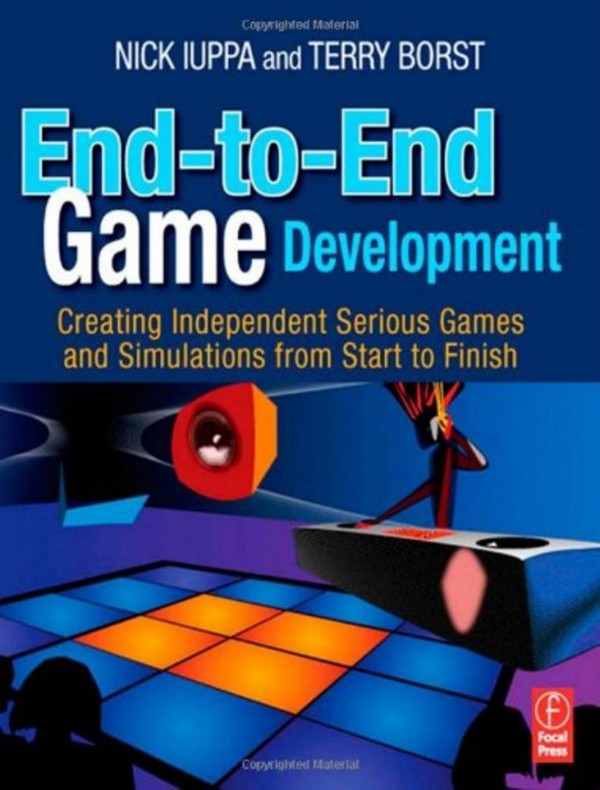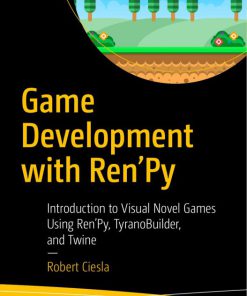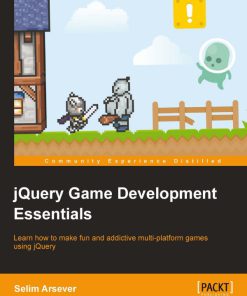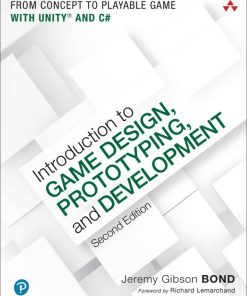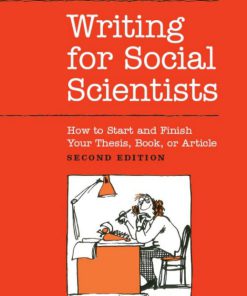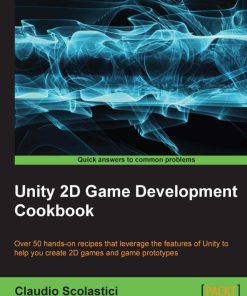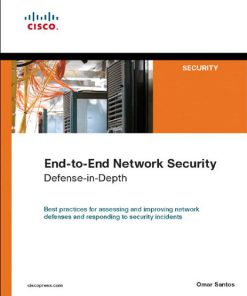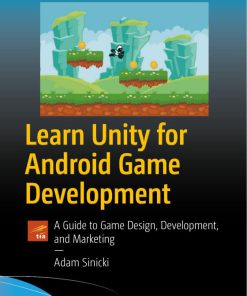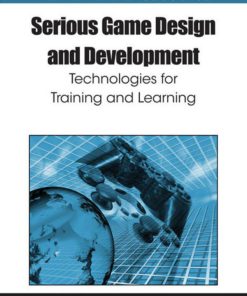(Ebook PDF) End to End Game Development Creating Independent Serious Games and Simulations from Start to Finish 1st edition by Nick Iuppa, Terry Borst 1136137173 9781136137174 full chapters
$50.00 Original price was: $50.00.$25.00Current price is: $25.00.
Authors:Nick Iuppa , Series:Gaming [46] , Author sort:Iuppa, Nick , Languages:Languages:eng , Published:Published:May 2010 , Publisher:Focal Press
End-to-End Game Development Creating Independent Serious Games & Simulations from Start to Finish 1st edition by Nick Iuppa, Terry Borst – Ebook PDF Instant Download/DeliveryISBN: 1136137173, 9781136137174
Full download End-to-End Game Development Creating Independent Serious Games & Simulations from Start to Finish 1st edition after payment.
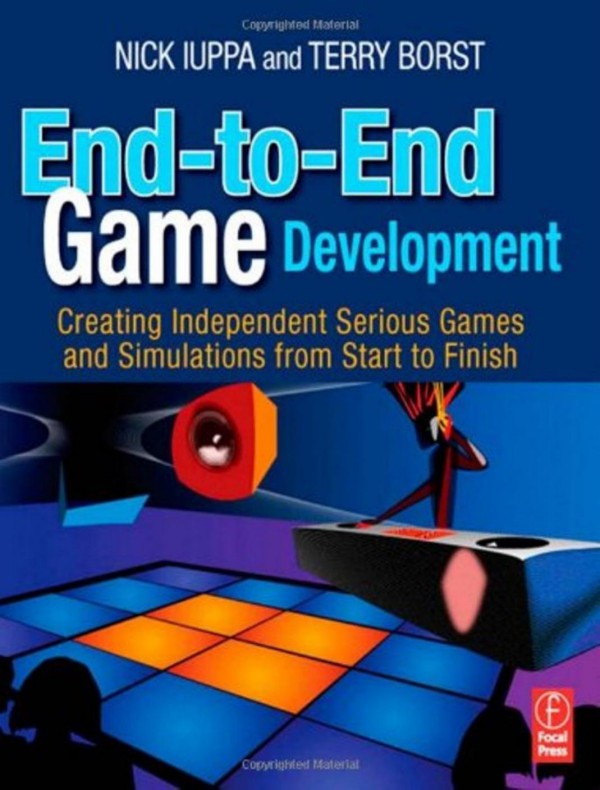
Product details:
ISBN-10 : 1136137173
ISBN-13 : 9781136137174
Author : Nick Iuppa, Terry Borst
You’re part of a new venture, an independent gaming company, and you are about to undertake your first development project. The client wants a serious game, one with instructional goals and assessment metrics. Or you may be in a position to green light such a project yourself, believing that it can advance your organization’s mission and goals. This book provides a proven process to take an independent game project from start to finish. In order to build a successful game, you need to wear many hats. There are graphic artists, software engineers, designers, producers, marketers – all take part in the process at various (coordinated) stages, and the end result is hopefully a successful game. Veteran game producers and writers (Iuppa and Borst) cover all of these areas for you, with step by step instructions and checklists to get the work done. The final section of the book offers a series of case studies from REAL indy games that have been developed and launched succesfully, and show exactly how the principles outlined in the book can be applied to real world products. The book’s associated author web site offers ancillary materials & references as well as serious game demos and presentations.
End-to-End Game Development Creating Independent Serious Games & Simulations from Start to Finish 1st Table of contents:
1. Introduction
New Tools Replace Old Tools
Would You Like to Make a Game?
What This Book Is About
2. Defining Independent Games, Serious Games, and Simulations
The Minefield of Terminology
Independent Games
Serious Games
Simulations
The Book’s Shorthand
Summary
3. From Start to Finish: A Walkthrough
Introduction
Section 1: Setting up Game Development
Section 2: Determining Project Goals
Section 3: Game Design — The Creative
Section 4: Game Design — The Technical
Section 5: Production and Authoring
Section 6: The Finish Line
Summary
Section 1: Setting Up Game Development
4. Getting Started
Introduction
What It Takes to Get Started
The Role of the Entrepreneur
The Moral of the Fable
The Role of the Wizard
1. Get Your Ideas Squared Away
2. Set up Your Team
3. Plan
4. Build a Demo or Prototype
5. Create a Business Plan
6. Create a Budget
7. Prepare Your Pitch
The Road Ahead
Summary
5. Client Acquisition
Introduction
Marketing versus Sales
Sales
Prospecting
Gather Referrals s
Make the Appointment
Demonstration versus Prototype
Prepare the Pitch
Make the Pitch
Don’t Get Discouraged
Summary
6. Client Management
Introduction
Making Friends with the Customer?
Dealing with International Customers
WorkYourTail Off!
Manage Client Expectations
Take Responsibility
Egos, Personalities, and Politics
A Few More Client Management Tips
Summary
7. Legal Issues
Introduction
All about Lawyers
Ignorance Does Not Excuse
Nondisclosure Agreements
Subcontracts with Your Vendors
Contracts with Clients
The Statement of Work
New Contracts and Contract Extensions
Patents
Spec Work
Self-Promotion Spec Work
Startup Spec Work
Summary
8. Team Building
Introduction
Assembling the Team
The Job Interview
Salaries
Other Incentives
Credits
Job Titles
Managing the Team
Goals and Commitments
Summary
9. Project Planning
Introduction
Creating the Project Timeline
Accurate Estimates
Worst-Case Scenarios and Risk Management
Solutions to Timeline Problems and Worst-Case Scenarios
Turn Linear Activities into Parallel Activities
Staffing and Overtime
Focus
Gaining Consensus
Budgeting
Overhead
Travel
Licensing Agreements
Salary Charges
Benefits and Overtime Charges
Payments
Media Production
Business Development and Meetings
Contingencies
Production Fees and Profit
Solutions to Budgeting Problems
Summary
10. Project Management
Introduction
Management Challenges
Management Skills
Sharing the Vision
Managing Workflow
Making Decisions
Philosophies of Project Management
Tools of the Trade
Summary
Section 2: Determining Project Goals
11. Game Design and Instructional Design
Introduction
The Horrors of Instructional Design
The Need for Instructional Design
The Process
The Premise
Other Characters
Business
The Pay-off
The Comparison
Summary
12. Determining Project Goals through Analysis
Introduction
Needs Analysis
Subject Matter Experts
Types of SMEs
Conducting the Needs Analysis
Task Analysis
Establishing Performance Criteria
Case Study Examples
Expectation Violations
Analysis
Summary
13. Instructional Design
Introduction
Demonstrate-Practice-Test
Step Size
Order of Presentation (Shaping)
Procedures
Sequencing
Chaining
Discrimination Problems
Competition and Discrimination
Job Aids versus Instruction
Fading
Coaching and Intelligent Tutoring
Generalization Problems
Inductive Reasoning
Limitations of Inductive Gameplay
Testing and Scoring
Scoring
Scoring System
Scoring Calculation
Score Reporting
After-Action Reviews
Scoring for Professional Certification
Summary
14. Instructional Design for Advergames and Promotional Games
Introduction
Needs Analysis for Advergames
Task Analysis for Advergames
Learning Problem Analysis for Advergames
Order of Presentation
Competition
Inductive Training
Job Aids
Summary
Section 13: Game Design: The Creative Side
15. Determining Simulation Activity
Introduction
The Whole Shooting Match
Isolated and Integrated Simulations
Finding the Core
First-Person Simulations
Total Integration
Summary
16. Gameplay Design
Introduction
Traditional Gameplay Navigation and Interaction
Classic Gameplay Mechanics
Matching Mechanics to Objectives
Making Games Fun: A Proven Process
Research and Saturation
Creative Brainstorming
Metaphors That Give Structure
Gameplay
Guided Paths versus Branching
The Clever Player
The Gaming Experience
Applying This Process to Serious Games
Creative Questions That Lead to Better Gameplay
Player-Characters(Avatars)
Navigation
Objects
Game Mechanics
Key Gameplay Concepts
Fun
Choice
Rewards/Progress
Risk versus Reward
Immersion
Pillars
Summary
17. The Concept Document
Introduction
Defining the Concept Document
An Approach
Integrating Analyses and Instructional Design into the Concept Document
Concept Document Dos and Don’ts
Dos
Don’ts
Concept Document as a Sales Tool
Can There Be More Than One Concept Document?
Finalizing the Concept Document
Summary
18. Concept Testing and Refinement
Introduction
Concept Testing
The Pitch
Concept Boards
Paper-and-Pencil Concept Testing
Demos
Prototypes
Developmental Testing and Refinement
Prototype Testing
Summary
Section 4: Game Design: The Technical Side
19. Development and Delivery Platforms
Introduction
Why Are We Waiting So Long to Choose a Platform?
Key Questions
Platform Pros and Cons
Personal Computers
Game Consoles
Televisions (DVDs, Set-Top Devices)
Mobile Devices
The Web Browser (Internet Explorer, Firefox, Safari,Chrome, Opera)
Second Life/Virtual Worlds
Summary
20. Selecting Development Tools
Introduction
Game Engines
Traditional Game Engines
Summary
21. The Design Document
Introduction
The Design Document Parado
So What Goes into a Design Document?
Examples of Design Document Content
Narrative
Technical Design
Gameflow Process
Don’t Listen When Someone Tells You That You Don’t Need a Design Document
Design Document Version History
Production Documents
Lists
Game Scripts
Marketing Document
Summary
Section 5: Production And Authoring
22. GraphicsDevelopment
Introduction
Preliminary Design
Creating Characters and Objects
Environments and Game Engines
Animation
Lip Sync
Special Effects
Cut Scenes/Cinematics
Engineering
Summary
23. Media Production
Introduction
Asset Management
Finding a Production Company
Do-It-Yourself Production
Casting
Audio Recording
Location Scouting
Green Screen
Preproduction
Production
Lighting
Directing the Shoot
Music and Sound Effects
Make Your Own Music
Original Composition
Licensing Music
Tips for Your Music Soundtrack
Sound Effects
Audio/Video Postproduction
The Rough Cut
The Final Cut
Sound Editing
Summary
24. The Production Pipeline
Introduction
Milestones
From Concept Phase to Alpha Phase
Alpha Phase
Beta Phase: Part 1
Potential Bottlenecks
Attack of the Feature Creep
Beta Phase: Part 2
Summary
25. Final Product Testing
Introduction
Alpha and Beta Testing
The End Time
Applying Big-Time Practices to Small-Time Jobs
Testing in the Field
QA and Certification
Minimizing the Pain
Summary
Section 6: The Finish Line
26. Packaging,Distribution, and Marketing
Introduction
Packaging
Packaging Cautions and Considerations
Physical Packaging
Digital Packaging
Ratings and Certifications
Distribution
Physical Distribution
Digital Distribution
Marketing
Intraorganizational Training Research Application
Professional Training Application
Summary
27. Assessment
Introduction
Assessing the Value of a Serious Game
Bogus Assessment Techniques
Promotional/Marketing Game Assessments
Persuasive Game Assessments
Usability Assessments
Attitudinal Assessments
People also search for End-to-End Game Development Creating Independent Serious Games & Simulations from Start to Finish 1st:
independent game development
indie game development process
developing an indie game
endeavor game development studio answers
creating indie game

